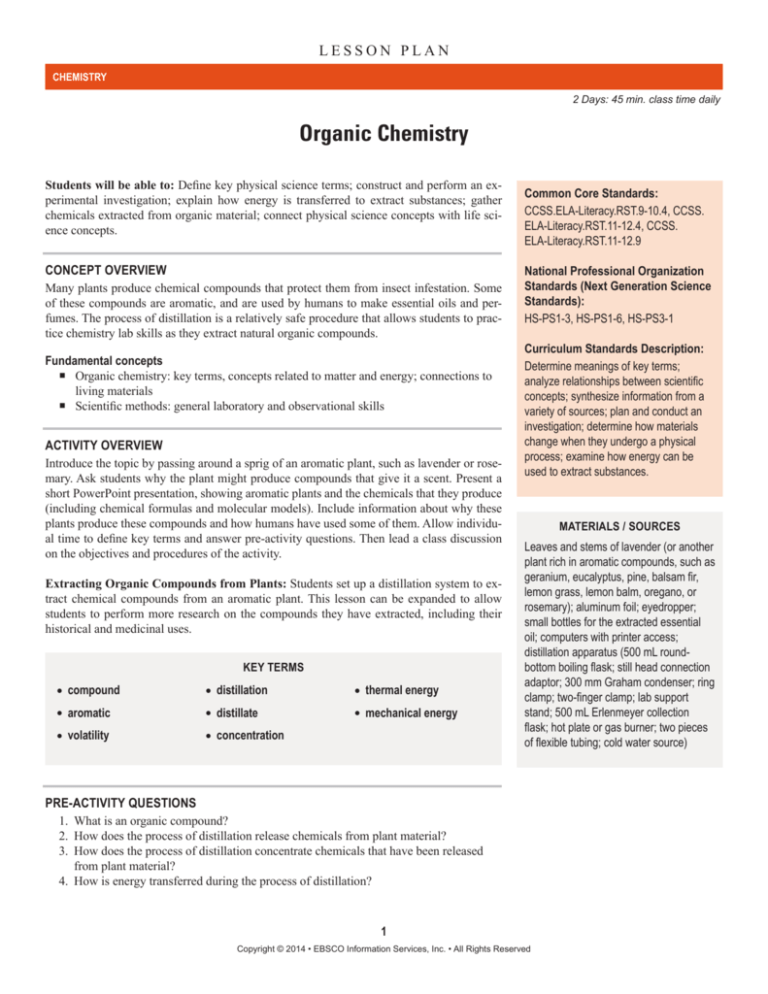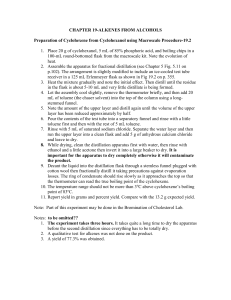
LESSON PLAN
CHEMISTRY
2 Days: 45 min. class time daily
Organic Chemistry
Students will be able to: Define key physical science terms; construct and perform an experimental investigation; explain how energy is transferred to extract substances; gather
chemicals extracted from organic material; connect physical science concepts with life science concepts.
CONCEPT OVERVIEW
Many plants produce chemical compounds that protect them from insect infestation. Some
of these compounds are aromatic, and are used by humans to make essential oils and perfumes. The process of distillation is a relatively safe procedure that allows students to practice chemistry lab skills as they extract natural organic compounds.
Fundamental concepts
Organic chemistry: key terms, concepts related to matter and energy; connections to
living materials
Scientific methods: general laboratory and observational skills
ACTIVITY OVERVIEW
Introduce the topic by passing around a sprig of an aromatic plant, such as lavender or rosemary. Ask students why the plant might produce compounds that give it a scent. Present a
short PowerPoint presentation, showing aromatic plants and the chemicals that they produce
(including chemical formulas and molecular models). Include information about why these
plants produce these compounds and how humans have used some of them. Allow individual time to define key terms and answer pre-activity questions. Then lead a class discussion
on the objectives and procedures of the activity.
Extracting Organic Compounds from Plants: Students set up a distillation system to extract chemical compounds from an aromatic plant. This lesson can be expanded to allow
students to perform more research on the compounds they have extracted, including their
historical and medicinal uses.
KEY TERMS
•• compound
•• aromatic
•• volatility
•• distillation
•• distillate
•• concentration
•• thermal energy
•• mechanical energy
Common Core Standards:
CCSS.ELA-Literacy.RST.9-10.4, CCSS.
ELA-Literacy.RST.11-12.4, CCSS.
ELA-Literacy.RST.11-12.9
National Professional Organization
Standards (Next Generation Science
Standards):
HS-PS1-3, HS-PS1-6, HS-PS3-1
Curriculum Standards Description:
Determine meanings of key terms;
analyze relationships between scientific
concepts; synthesize information from a
variety of sources; plan and conduct an
investigation; determine how materials
change when they undergo a physical
process; examine how energy can be
used to extract substances.
MATERIALS / SOURCES
Leaves and stems of lavender (or another
plant rich in aromatic compounds, such as
geranium, eucalyptus, pine, balsam fir,
lemon grass, lemon balm, oregano, or
rosemary); aluminum foil; eyedropper;
small bottles for the extracted essential
oil; computers with printer access;
distillation apparatus (500 mL roundbottom boiling flask; still head connection
adaptor; 300 mm Graham condenser; ring
clamp; two-finger clamp; lab support
stand; 500 mL Erlenmeyer collection
flask; hot plate or gas burner; two pieces
of flexible tubing; cold water source)
PRE-ACTIVITY QUESTIONS
1. What is an organic compound?
2. How does the process of distillation release chemicals from plant material?
3. How does the process of distillation concentrate chemicals that have been released
from plant material?
4. How is energy transferred during the process of distillation?
1
Copyright © 2014 • EBSCO Information Services, Inc. • All Rights Reserved
EXTRACTING ORGANIC COMPOUNDS FROM PLANTS
1. Practice lab safety by putting on a protective apron and
goggles. Tie long hair back and have waterproof and
heat-proof gloves available before beginning the lab.
2. Put on the waterproof gloves and tear the plant material
into small pieces. Place these pieces into the roundbottom boiling flask. Then fill the flask halfway with
water.
3. Set up the distillation apparatus. The flask filled with
plant material and water should be set up on a ring
clamp above the heat source (that has not been turned
on yet). The flask should be connected to the Graham
condenser, which is set up on a lab support stand. The
open end of the condenser should be set up to empty
into the Erlenmeyer flask. One piece of flexible tubing
should be connected to both the condenser and a cold
water source; the other should be connected to the
condenser and should empty into the sink.
4. When your setup is complete, turn on the cold water
source and verify that it is running through the condenser and then back out into the sink. Leave the water on
throughout the distillation.
5. Turn on the heat source and bring the water in the
round-bottom flask to a boil. Keep it on a low boil
throughout the distillation. Be careful when working
with the apparatus from this point forward, because
some glassware will be hot. Avoid putting cold water
into hot glassware to prevent shattering.
6. Monitor the apparatus to prevent boiling over. Also be
sure that the distillate is running into the Erlenmeyer
flask.
7. Continue the process of distillation until the plant
material loses its color or water levels get low in the
round-bottom flask. Then remove the heat source and
turn off the water to the condenser.
8. Allow the apparatus to cool down before you take it
apart.
9. Cover the top of the Erlenmeyer flask with aluminum
foil. Allow the distillate to sit overnight. There should
be a thin layer of oil on top of the distillate the next day.
Use an eyedropper to remove the oil and place it in a
small container.
Evaluation
Students present a container of essential oil from their plant material as a product of their distillation. They obtain information from
the Internet about the chemical composition of the oil and its potential uses. They present this information in the form of an informational pamphlet.
Closure: Students discuss the distillation process and describe what happened to the organic compound at each step in the process.
They also explain how energy changed forms to allow the distillation. Students discuss any problems they experienced, and any
thoughts they had about making the process easier or more effective at extracting essential oil.
RELATED LITERATURE
Séguin, Margareta. The Chemistry of Plants: Perfumes, Pigments, and Poisons. London: Royal Soc. of Chemistry, 2012. Print.
Wormwood, Valerie A. The Complete Book of Essential Oils and Aromatherapy. Novato: New World Lib., 1991. Print.
Related Database Search - ((“plant extracts” or smell or scent or pheromone or “essential oils”) and (extraction or chemical or
distillation) and (plant or herb or flower))
Related Image Search - (((condensation or distillation) and (process* or energy or chemistry)) or ((lavender or geranium or eucalyptus or pine or balsam or lemon or oregano or rosemary) and (plant or flower or leaves or leaf) NOT koala))
2
Copyright © 2014 • EBSCO Information Services, Inc. • All Rights Reserved






